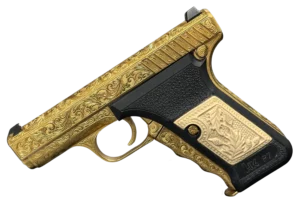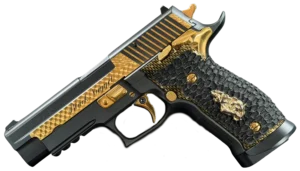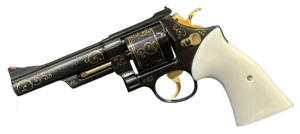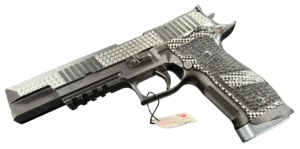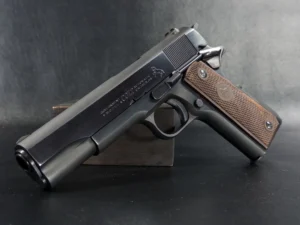Key Takeaways:
- The Colt Peacemaker wasn’t just a revolver — it was a character in America’s story: More than hardware, it symbolized grit, lawlessness, and the chaos of the Wild West. Whether in the hands of a sheriff or an outlaw, it meant something… and it still does.
- Its legacy isn’t built on specs alone — it’s built on who carried it, and why: Wyatt Earp, Billy the Kid, cavalry soldiers — the Peacemaker was their companion. Its staying power comes from those stories, not just its steel.
- Even now, the Peacemaker hasn’t faded — it’s just changed hats: From old battlefields to glass display cases, and from movie sets to modern shooting matches, the Colt Peacemaker keeps showing up. Somehow, a 150-year-old six-shooter still refuses to be forgotten.
Some guns are just guns. Tools. Nothing more.
Then there’s the Colt Peacemaker.
Even the name carries weight, like a whisper from the past that somehow still echoes today. Also known as the Single Action Army, this revolver wasn’t just another weapon. It was the sidearm of sheriffs, outlaws, soldiers, and silver-screen cowboys. It was, depending on who held it, either justice or trouble—sometimes both.
But before it became an icon of the American West, it started as a simple idea: build a reliable sidearm tough enough for the frontier.
Where It All Began
Let’s rewind to the 1870s. America was expanding fast. Railroads, settlers, lawmen, and, yeah, a fair share of gunfights were carving up the frontier. The U.S. military needed something better than what they had. Enter Samuel Colt—or more accurately, his company.
Now, Sam Colt had already passed away by then, but his legacy was alive and kicking. The Colt Manufacturing Company stepped up and designed a new revolver that checked every box: simple, rugged, dependable. Chambered in .45 Colt, the Peacemaker hit the scene in 1873 and immediately found its way into the holsters of U.S. Cavalry troops.
It wasn’t fancy. But it worked. And in the unforgiving landscape of the American West, that mattered more than anything.
The Man Behind the Machines
Let’s take a quick detour here.
Samuel Colt—now there’s a character. He wasn’t just an inventor; he was a showman, a marketer, a visionary who saw guns not as singular tools but as scalable machines. One of his biggest ideas? Interchangeable parts. Simple in hindsight, but revolutionary at the time.
This idea made Colt guns more reliable and easier to mass-produce. You didn’t need a blacksmith to fix a busted spring. You just swapped it out. That approach to manufacturing changed the industry—and set the stage for the Peacemaker’s rise.
And while Colt didn’t live to see the Peacemaker’s debut, its DNA was unmistakably his. Even the engraved scrollwork and polished finishes had a flair that felt… well, theatrical.
“The Gun That Won the West”
You’ve probably heard that phrase before—on an old poster or a dusty museum plaque. “The Gun That Won the West.” It’s a bold claim, sure. But the Peacemaker might actually deserve it.
From frontier forts to saloons in Dodge City, this revolver was everywhere. Lawmen like Wyatt Earp swore by it. Outlaws like Billy the Kid? Yeah, they carried it too. The irony writes itself.
This wasn’t just a gun—it was a sidekick, a statement, sometimes a last resort. And whether it was slung low in a leather rig or tucked under a gambler’s waistcoat, it meant business.
More than that, it was reliable. When things went sideways—and they often did—it fired when it had to. That kind of dependability? Lifesaving.
Let’s Talk Mechanics
At its core, the Colt Peacemaker was a single-action revolver. That means you had to manually cock the hammer before each shot. Slower than modern double-action pieces, sure—but more deliberate. There’s something poetic about it, really. You had to mean it.
It originally came chambered in .45 Colt, though later variants offered other calibers. And then there were the barrel lengths. Short-barrel versions were called “Sheriff’s Models.” The longer ones—like the 7.5-inch barrel—were often carried by cavalry units. Each one had a different feel, a different purpose.
Balance-wise? Spot on. The grip filled the hand without feeling bulky, the weight helped tame recoil, and the mechanics were smooth, even by today’s standards.
But maybe what set it apart was its look. Even the “plain” versions had a kind of rugged elegance. Blued steel, case-hardened frames, walnut grips. And if you had money to spend? Custom engravings, ivory handles, gold inlays. Some were downright royal.
The Wild, Weird, and Worldly West
Here’s where things get interesting. The Peacemaker wasn’t just a military tool or a cowboy’s backup. It became a character in its own right—a symbol of the American myth.
We’ve all seen it in Westerns, right? The showdown at high noon, the slow draw, the click of a hammer before the shot rings out. Directors loved it because it looked right. Writers loved it because it symbolized a kind of stripped-down justice.
It wasn’t long before the gun started showing up in every kind of media—films, comics, video games. From John Wayne to Clint Eastwood, the Peacemaker became shorthand for grit, resolve, and that particular brand of American storytelling where morality is muddy but the trigger is always clean.
Who Carried One?
Honestly? Pretty much everyone who mattered in the Old West.
Wyatt Earp carried one at the O.K. Corral. That image—him, Peacemaker in hand, wading through gunfire—became legendary. Billy the Kid was another. His gunfights may have been less romantic than Hollywood would have you believe, but his Peacemaker was real enough.
Then there were the Buffalo Soldiers, Pinkerton agents, cattlemen, stagecoach guards—people who needed a gun they could trust when things went south fast. The Peacemaker wasn’t fancy unless you wanted it to be. It just worked.
And that’s probably why so many stories—real or embellished—feature it. It was the common thread that tied together an entire, chaotic chapter of American history.
From Battlefields to Display Cases
Here’s the thing: as much as the Peacemaker was built for action, it was also made to last.
Collectors today are obsessed with original Colts. Especially first-generation models, which ran from 1873 to 1941. Got one with a verified serial number and some provenance—say, carried by a lawman or linked to a historical event? You’re looking at serious money.
Even “shooter-grade” models with less polish and more wear still fetch a premium. Because owning one feels like holding a piece of America. It’s tactile history. And there’s something deeply compelling about that.
Colt Brings It Back
You’d think after a certain point, the Colt Peacemaker would fade into nostalgia. Not quite.
Colt actually resumed production in the 1950s, partly thanks to the Western craze in film and television. Suddenly, everyone wanted their own “cowboy gun.” The company leaned into that demand, and modern reproductions hit the shelves.
These weren’t just collector pieces. People shot them in cowboy action shooting matches, reenactments, eand ven casual plinking at the range.
And honestly, shooting a Peacemaker—original or modern—is an experience. The mechanical feel, the deliberate pace, the sharp report of each shot—it’s got soul. You feel it in your bones.
More Than a Gun
Let’s pause and zoom out for a second.
The Peacemaker isn’t just a story about hardware or ballistics. It’s about identity. For better or worse, the revolver became a stand-in for an entire era of American history—a time defined by expansion, conflict, independence, and contradiction.
It was the tool of sheriffs trying to bring order. The weapon of outlaws fighting the same lawmen. It sat on the hips of soldiers and showmen alike. And through it all, it became more than a weapon. It became a symbol.
There’s something haunting about that. A little melancholic, too. Because for all the freedom and grit the Peacemaker represented, it also reminds us how turbulent that era really was.
Still Kicking
Even now, over 150 years later, the Colt Peacemaker refuses to be forgotten.
Modern reproductions keep the design alive. Historians keep their story in the conversation. And collectors? They keep it polished and protected, sometimes never firing a shot—because the value isn’t just in the bang. It’s in the story.
And make no mistake, it still shows up in pop culture. From prestige dramas to stylized video games, the Peacemaker is shorthand for a certain kind of frontier justice. Sometimes glorified. Sometimes questioned. But always remembered.
Final Thought
The Colt Peacemaker was never just a gun. It was—and still is—a mirror reflecting how America sees itself: brave, restless, flawed, and deeply committed to its own mythology.
It came from a specific time and place, but weirdly enough, it never really left. And maybe that’s the secret to its legend. Not just that it was there when the West was won—but that, somehow, it still matters.
Like all good stories, the Peacemaker’s isn’t over. Not yet.
Frequently Asked Questions
Because, frankly, it was everywhere during the American frontier days. Soldiers, lawmen, outlaws — they all carried it. Its reliability made it a favorite, but it’s the stories behind it that cemented its legend. It wasn’t just a tool; it became part of the mythos.
Oh, absolutely. The U.S. Army adopted it in 1873, and it saw action in the Indian Wars. Beyond that, it was practically standard issue for lawmen in the Wild West and a go-to choice for gunfighters. The shootouts weren’t just movie magic — they happened, and the Peacemaker was often involved.
The originals (especially first-generation models from 1873 to 1941) are the real deal — hand-fitted, historically significant, and often collector’s gold. Modern reproductions are mechanically faithful but lack the historical mileage. Still, they’re popular among shooters and reenactors. Think of it like owning an original ’69 Mustang versus a perfect replica — both are cool, but one has a story under the hood.
Nope — he died before it was made. However, his company built it, and his influence is evident throughout. The manufacturing methods, the interchangeable parts, even the showmanship in the design — that’s classic Colt DNA.
Technically, yes — in various forms. Colt restarted production in the 1950s due to popular demand, and other companies have also made faithful reproductions. Whether you’re a collector or want to feel like a cowboy at the range, you’ve got options.



